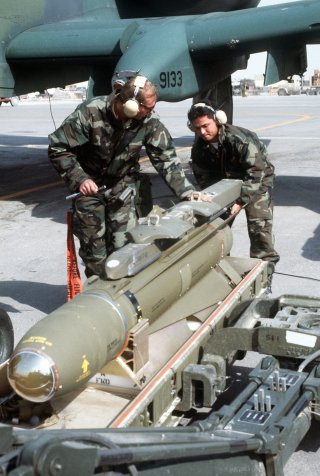Aviation History: The Story of the GAM-63 RASCAL Air to Surface Missile
A total of five of the GAM-63 RASCALs survived today, and are on display.
Here's What You Need to Know: In 1958, shortly before the first Rascal unit was to become operational, the U.S. Air Force canceled the program in favor of the more reliable and longer-range Hound Dog missile.
During the Second World War, the United States Army Air Force (USAAF) closely studied how Nazi Germany’s Luftwaffe utilized Heinkel He 111 medium bombers to air-launch V-1 missiles. In total, the German military successfully launched more than 1,000 of the missiles while in flight.
The United States conducted its own testing, using the B-17 heavy bombers and the JB-2 Loon, an American-made copy of Nazi Germany’s V-1. The war ended before the platform could be employed, but the tests were successful enough that after the war, the Army Air Forces opted to move forward to develop an air-to-surface missile. In May 1947 it awarded the Bell Aircraft Company a contract for the construction of a supersonic air-to-missile compatible with the Boeing B-29 Superfortress, the Convair B-36 Peacemaker, and the Boeing B-50 Superfortress bombers.
Bell Aircraft Corporation, as the prime Weapon System Contractor, immediately initiated its design, development, and fabrication of Shrike, a supersonic test missile, which had a 50-mile range and was capable of carrying a 1000-pound special warhead. This led to the development of the full-scaled ASM-A-2 missile, a “stand-off” nuclear weapon that could be launched from Strategic Air Command (SAC) bombers up to 100 miles from a target.
The platform was re-designated as the B-63 in 1951, and subsequently re-designated the GAM-63 in 1955—while the name “RASCAL” was actually the acronym for RAdar SCAnning Link, the missile’s guidance system.
The GAM-63 was powered by a Bell XLR-67 three-chamber liquid fuel rocket engine, which provided 10,440 pounds of thrust. It had a maximum speed of 1,950 mph. It was almost thirty-two feet in length and had a wingspan of sixteen feet, eight inches. It weighed 18,200 pounds and could carry a W-27 nuclear warhead, which offered an airburst or surface detonation mechanism.
The first launch of a guided Rascal took place in October 1953 from a Boeing DB-47 carrier aircraft, and in tests, it performed with mixed success. During 1954, the capabilities of the Rascal Weapon System were then demonstrated during the subsequent flight testing over the course of eighteen missiles—which included search radar and microwave link operation, power plant performance and control, remote control of the missile during terminal guidance, and missile performance at high altitudes. A free-drop configuration and technique was devised for the RASCAL and was successfully proven during the launching of ten missiles; a technique that is now standard procedure. Vital structural and aerodynamic data were obtained from the flight test program.
However, in 1958, shortly before the first Rascal unit was to become operational, the U.S. Air Force canceled the program in favor of the more reliable and longer-range Hound Dog missile.
A total of five of the GAM-63 RASCALs survived today, and are on display. One is at American Legion Post 170 in Midwest City, Oklahoma while another is on display at the Goddard Junior High athletic field in Midland, Texas. The Castle Air Museum in Atwater, California is home to one of the missiles, while one is now on display at the Air Force Space & Missile Museum, Cape Canaveral Space Force Station (SFS), Florida. An XGAM-63 prototype is in the collection of the National Museum of the United States Air Force at Wright-Patterson Air Force Base (AFB), Dayton, Ohio.
Peter Suciu is a Michigan-based writer who has contributed to more than four dozen magazines, newspapers, and websites. He regularly writes about military small arms and is the author of several books on military headgear including A Gallery of Military Headdress, which is available on Amazon.com.
Image: U.S. Air Force, Flickr.

